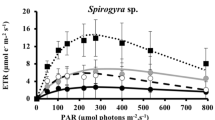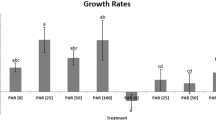Abstract.
Long-term effects of artificial ultraviolet radiation (UV) and natural solar radiation on growth and photosynthetic activity, as measured by chlorophyll fluorescence, were investigated in 13 different polar and cold-temperate macroalgal species. Isolates of five different species from the Arctic and Antarctic were exposed to different light treatments of photosynthetically active radiation (PAR), PAR+UVA and PAR+UVA+UVB. Eight different species collected on the island of Helgoland, North Sea, Germany, were studied in the laboratory and under natural solar radiation conditions. Increase in fresh weight and changes in photosynthetic performance were monitored over a period of 3–4 weeks. The sublittoral polar species, particularly the Antarctic red algal species Gymnogongrus antarcticus and G. turquetii, the Arctic cold-temperate brown alga Alaria esculenta and, very drastically, the Arctic-endemic Laminaria solidungula, exhibited strong inhibiting effects of artificial UVB radiation on growth. In the cold-temperate sublittoral growth of the red algae Phycodrys rubens and, to a lesser extend, Membranoptera alata was substantially inhibited by UV radiation. In contrast, eulittoral species, e.g. Fucus serratus, did not show any differences in growth with respect to artificial irradiation conditions, with or without UV radiation. In the laboratory, some individuals of the green alga Codium fragile exhibited strong morphological changes of the whole thallus, particularly under UVB exposure. In the experimental outdoor set up, growth of most of the algal species was already inhibited by the full solar UV waveband, but, apart from Polyides rotundus, no additional UVB effect could be detected. Changes of in vivo fluorescence were not always consistent with the measurable changes in growth rate, indicating that physiological processes leading to an inhibition of growth may act independently of changes in photosynthetic activity. For the polar species, a general correlation between the natural vertical distribution in the field and the individual sensitivity towards UV radiation was indicated, while for eulittoral species from Helgoland no clear relationship was found. The obtained results show that measuring growth is a good ecological parameter to monitor long-term effects of UV radiation on single macroalgal species and the possible resulting changes of whole algal communities in coastal ecosystems.
Similar content being viewed by others
Author information
Authors and Affiliations
Additional information
Electronic Publication
Rights and permissions
About this article
Cite this article
Michler, .T., Aguilera, .J., Hanelt, .D. et al. Long-term effects of ultraviolet radiation on growth and photosynthetic performance of polar and cold-temperate macroalgae. Marine Biology 140, 1117–1127 (2002). https://doi.org/10.1007/s00227-002-0791-z
Received:
Accepted:
Issue Date:
DOI: https://doi.org/10.1007/s00227-002-0791-z




